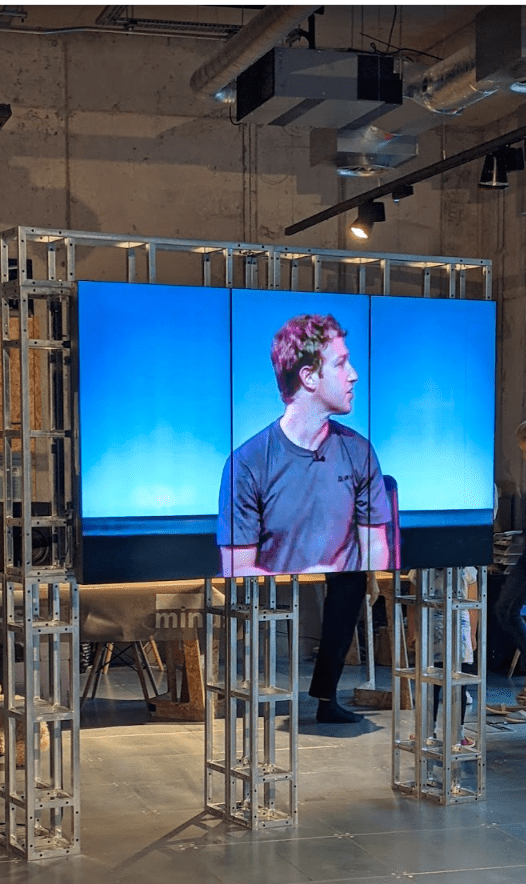
Over the last couple of decades our relationship with software has been a tumultuous one. We’ve seen smartphone apps which are in essence, posh web sites, while at the other end of the scale exist complex applications presented in super-simple interfaces a la Google.
As that relationship became more about profit, the internet and its software began to seem a touch more toxic. The civil rights of the average internet citizen have taken a pounding in recent years: as evidenced in documentaries like Terms The Social Dilemma and pay-per-click geopolitical psy-op scandals from the likes of Cambridge Analytica.

Our rights to privacy have been repeatedly trampled on by marketing companies looking to gain an advantage over their competition.
It makes sense then for art practice to include pulling apart the veneer of the machine; a persistent and vital theme at London-based Arebyte gallery, residing in its newest incarnation at Canning Town’s hyper-real City Island.
Following this thread Ben Grosser’s latest exhibition at Arebyte feels a lot more pertinent than it might otherwise by investigating the quantification behind social media’s nudges influencing our online behaviours.
Opened on the 19th August was Arebyte’s latest IRL exhibition from US-based Ben Grosser, titled Software for Less. The show features a selection of 16 artworks, in flavours of IRL audiovisual presentations and and URL, Arebyte’s now-familiar form of browser plug-ins to allow the audience to continue the discourse at their leisure.

Mark Zuckerberg is presented as an unmissably familiar face upon entry to the space; but given the motivations of the works, it’s a flavour of familiarity similarly afforded to the likes of Hellraiser or Freddy Krueger.
The first work that caught the ear and eye upon entry yielded an immediate sense of corporate-eeriness. It’s an audiovisual presentation of the Facebook founder waxing lyrical about growth on conference stages, expounding upon Zuckerberg’s ever-present creepiness with a suspenseful horror sound track, like the instant-classic recording slowed down cicadas singing in harmony, aka “God’s choir“. The subtle time-lapsed movements appeal to that sense of the eyes of a portrait following you around the room: limbs and facial expressions lapsing slowly and gradually compelling a melting and convincing portrait of the data-sleaze.
The room is filled with these virtual portraits, like a creepy group photo taken by the CIA. It’s unnerving and yet somehow also very effective in its subtlety: it almost drives you to look away from something that at once compels your gaze but still holds up as a crafted media-art engagement enough for people who might be looking around warily.
Reversing the gaze, the supercut picks out Zuckerberg’s own obsessive tendencies toward quantifying growth. The cut aways into laughter or the thousand years stare of the audience members present de-emphasize the repetition and show a glimpse of emotion carved into the dense tapestry. Like a broken cassetteboy montage trying to re-assemble itself.

Starting with young Zuck, it’s a time-lapse of both the maturity of video quality and Zucks years, pinned together with the linguistic obsession with growth. The rapid edits convincingly play out timeless behavioural consistencies of social’s reptilian overlord.
Another experience of the same supercuts can be accessed by loitering by the speakers behind the TV screen, de-emphasizing the facial and activating a sense of raw minimalism veering toward a bizarre musique concrete. The cuts do work as just sound and the variety of close and far vocal recording leans into a new media experience which while chilling becomes somewhat addictive.
Moving onto other works, featuring more emoji and message-driven prompts which take aim at distilling the insistent prompts which social media delivers to us, we’re presented with a scaffolded outcome of the net-art aspect of the show. Grosser has put together browser plugins that replace people’s names with an opaque and vital “Someone” placeholder, activating a playful reduction of humanity and exposure of the social media algorithm’s intention to impact upon our dopamine receptors.
Generic updates from “someone” directly to “you” make for a playfully absurd distillation of the dopamine-triggering notification sluice, which is presented in a delightfully iridescent post-internet colour palette.
The sporadic imperative in the notifications to “see them before they disappear” amongst a cacophony of sound from the neighbouring pieces adds to the social media-as-horror B movie effect. The acoustical environment possesses a mix between language and the horror suspense, aggregating the works within the space
This in particular calls to mind the impermanence of the notification prompts nudging human behaviour in balance with the unsettling immutability of at-scale commercial data collection and the resulting psychological profiling of social media users, storing our behavioural data as name-tagged marionette puppets in datacentres. Not dissimilar to a serial killer’s collection of their victim’s paraphernalia. Thanks Zuck.
The emphasis is not just on Zuck and the Facebook suite. The obsession with quantification is keenly marked on Twitter with a video essay questioning its presentation of metrics and their resultant sculpting of self-esteem and desire.
While the works all tend to work like a single aesthetic, Grosser’s exhibition does not feel like one piece: it flows as a remarkable demonstration of focused versatility, with an aesthetic as political as it is empirical. The show invests in a successful attempt at de-fanging the dopamine dependency of media and, in doing so, empowers the audience to create their own investigative net-art experience by virtue of the plug-ins.
The Demetricator plugins for Facebook and Twitter enables an introspection of the artist’s ostensibly self-determined judgements: “disrupting social media metrics” asks a vital question: just who benefits from quantifying this content?
Remember: Somebody is following you.
Creepy.



